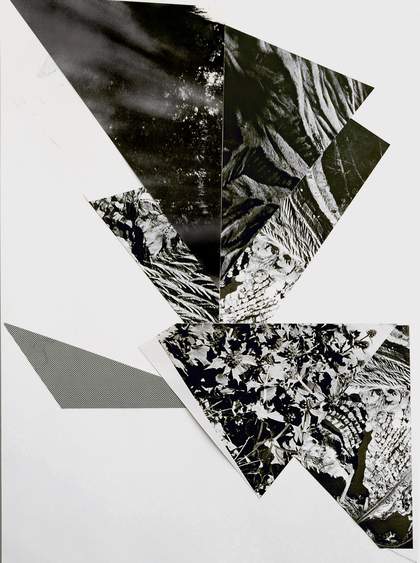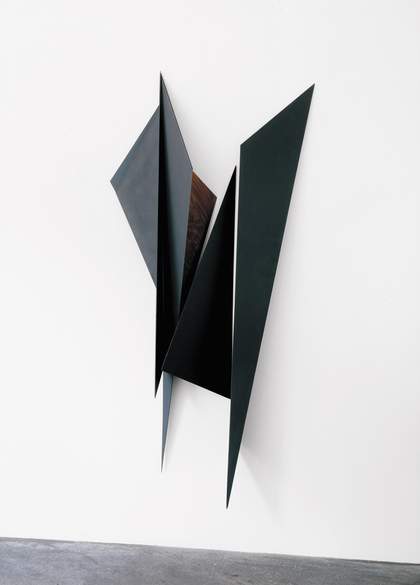Artists continue to move to Berlin at an amazing rate. A British gallery director on a recent visit told me that he thought Kreuzberg today is like SoHo was in the 1960s and 1970s. Katja Strunz’s studio is here, in one of the area’s many disused industrial buildings that have been taken over by artists, architects and designers. The spaces above and across from her are rented by Anselm Reyle and Uwe Henneken, artists she has known since her student days. The three met when they studied in Karlsruhe in the 1990s. They moved to Berlin together, joined the same gallery, Giti Nourbakhsch – and left at the same time, a few years later. Although they have gone in different directions, their work shares a playful appropriation of some of modernism’s key forms and themes. Henneken’s paintings, for instance, echo Surrealism, while the stick on strips in Reyle’s hard-edged, brightly coloured compositions clearly reference Minimalism. Strunz has become well-known for her neo-Constructivist wall sculptures. Something that the work of all three has in common is the emphasis it gives to the particularity and material qualities of the made object.
As I climb rather slowly up the stairs to Katja Strunz’s studio on a swelteringly hot July morning, it occurs to me that this new materialism is an implicit “rejoinder” (as Strunz calls it) to the kind of work to which the French critic Nicolas Bourriaud has given the name “relational aesthetics”. Strunz’s sculptures have the emphatic physicality and internal complexity that has been rejected by many artists since the heyday of Minimalism in the 1960s. For Bourriaud’s favourite artists, such as Pierre Huyghe, Rirkrit Tiravanija or Liam Gillick, the art object itself is relatively insignificant. What really matters to them is the activation of the spectator’s experience. Strunz’s works, on the other hand, seem to have a life of their own. Take her folded figures, for example, which look as if they might be a series of paper aeroplanes, except that they are too big, made out of wood and hang on the walls. As they hang there, you might perhaps see them as being like huge bats in resting positions, or, as I came to think when I was in her studio, looking at a wall full of half-finished or abandoned “folded” structures, a rack of costumes waiting to be worn on stage. The artist laughs when I mention this idea to her, and she is clearly not offended that her works provoke such speculative associations in the mind of the spectator. I find it all the more surprising then when she mentions Robert Smithson as an early inspiration.

Katja Strunz
Untitled 2002
Collage on paper
49.5 x 35.5 cm
© Katja Strunz
In her first years as an artist, she used to produce paintings, mostly of birds in flight. Then, in 1997, she found a space in Karlsruhe to show her work. It was a former officers’ mess on an abandoned US military base and it led her to start thinking about objects and their sites. The rooms’ former glory was apparent in the splendid wood panelling and stencilled wallpaper, but the building was falling into disrepair and the bare walls were beginning to show through. Order was giving way to entropy, artifice to nature. These are quintessential Smithsonian themes and Strunz responded by re-creating Smithson’s sharp crystalline structures in wood – Untitled from 1964–5. Her reconstruction lacked the mirror that Smithson had put into the metal frames in order to produce a reflection of the spectator within the objects – a crucial difference. In Strunz’s version, the two pointed triangular halves join in the middle in a way that reminds one of a Venetian carnival mask with hollow eyeholes. Where Smithson had played off organic structures against inorganic materials, Strunz’s sculpture turns on the tension between past memories and present perception. The allusions of her work are altogether more metaphorical than Smithson’s. Masks, bats, costumes – the associations well up in the mind of the spectator like haunting and uncertain memories.
A few years later Strunz produced a beautiful print, made with an exquisite old-fashioned letterpress, that somehow summarises her enterprise. It contains joined vertical and horizontal lines that might have been axes for plotting mathematical points in time and space. But instead of points the German word Zeittraum is written on the inside. Had it not been for the second “t”, the word would mean space-time (Zeit-Raum). The second “t”, however, brings a third association into play: the German word for dream – Traum. Space, time and dreams are central and recurring themes in Katja Strunz’s work. Like her angular neo-Constructivist wall sculptures, they return one to that generation of early twentieth-century avant-garde artists that pinned its hopes on the promises of the Russian Revolution. When Kasimir Malevich showed his famous black square in 1915 he intended it to be a tabula rasa: to signal the demise of the old forms and to herald the beginning of a new kind of experience of space and time. In the 1920s El Lissitzky carried the programme forward, hoping to develop an artistic language to correspond to Einstein’s new relativistic conception of space-time, one that would encourage revolutionary social forms. Both Malevich and Lissitzky are cited directly in Strunz’s work.
A set of off-cuts, collected haphazardly in a plastic bag, recalls one of the so-called Proun paintings by Lissitzky from the early 1920s. Yet photocopied and framed as it is in Untitled 1998, the final work is little more than a ghostly illusion, an anaemic reminder of past hopes and dreams. In another work, titled Black Angry Wall, exhibited at Gavin Brown’s Enterprise in New York in 2006, Malevich’s original black square now appears in different sizes and decentred on four letterpress prints, set below a cascade of black metal cubes. Where Malevich’s work was meant to point symbolically forwards and upwards into a better future, the direction here is downwards and backwards. Almost invisibly, black on black, the paper works carry imprints of the title and dates from the past: 1956–68, 1958–70, 1969–70. The top row still shows a kind of precarious order. After that it is as if the cubes were tumbling into space and time. Where there was once order, chaos sets in. Entropy takes hold.

Katja Strunz
Untitled 2001
Wood, paint
228 x 114 x 22 cm
Courtesy Cereal Arts, Philadelphia © Katja Strunz
The ruins of the past are apparent in the physical character of many of Strunz’s works. The metal cubes are worn and rusty, the paper is faded and found objects – fragments of wheels, scrap metal and discarded timber – are inserted into various wall sculptures. Relocated into the future-orientated forms of the 1920s Russian avant-garde, they are unable to live up to expectations. But although they lack the youthful energy to speak of better, brighter things to come, they do not mourn the passage of time or the failure of hopes. As we look at one of her more recent wall structures of assembled metal forms, the artist points to a curling piece of scrap metal. “Like a ribbon for a present,” she says with a twinkle in her eyes. Standing with one’s back to utopian ideals is not a comfortable position to maintain, and it is touches like this that give the work a lightness and brightness far different from the solemn funeral laments for modernity and its aspirations that are common currency among so many contemporary artists. An example of this is Einladung zur Angst (Invitation to Fear) from 2005, an installation consisting of found objects, including cymbals, hotel reception bells, candelabra, metal bowls, ashtrays and shapes that resemble parasols, arranged to look like an alternative brass band which appears as if it had marched into the gallery space to poke fun at the seriousness of the rest of her objects.
Mario Testino photographed Keira Knightley in front of one of them in Strunz’s studio for the September issue of American Vogue. There is nothing new in fashion following where artists lead – in this case into the postindustrial grunge of Berlin’s backyards. Fashion lives in the alluring but unrealistic world of desires. Strunz’s art, on the other hand, is working to bring us home to an impossible, but real, mode of being: the intolerable recognition that we inhabit a world of failed promises. Her work is more than a picturesque backdrop for a fashion plate – it is almost an immanent critique of it. As I walk down the stairs from the studio, I wonder if
